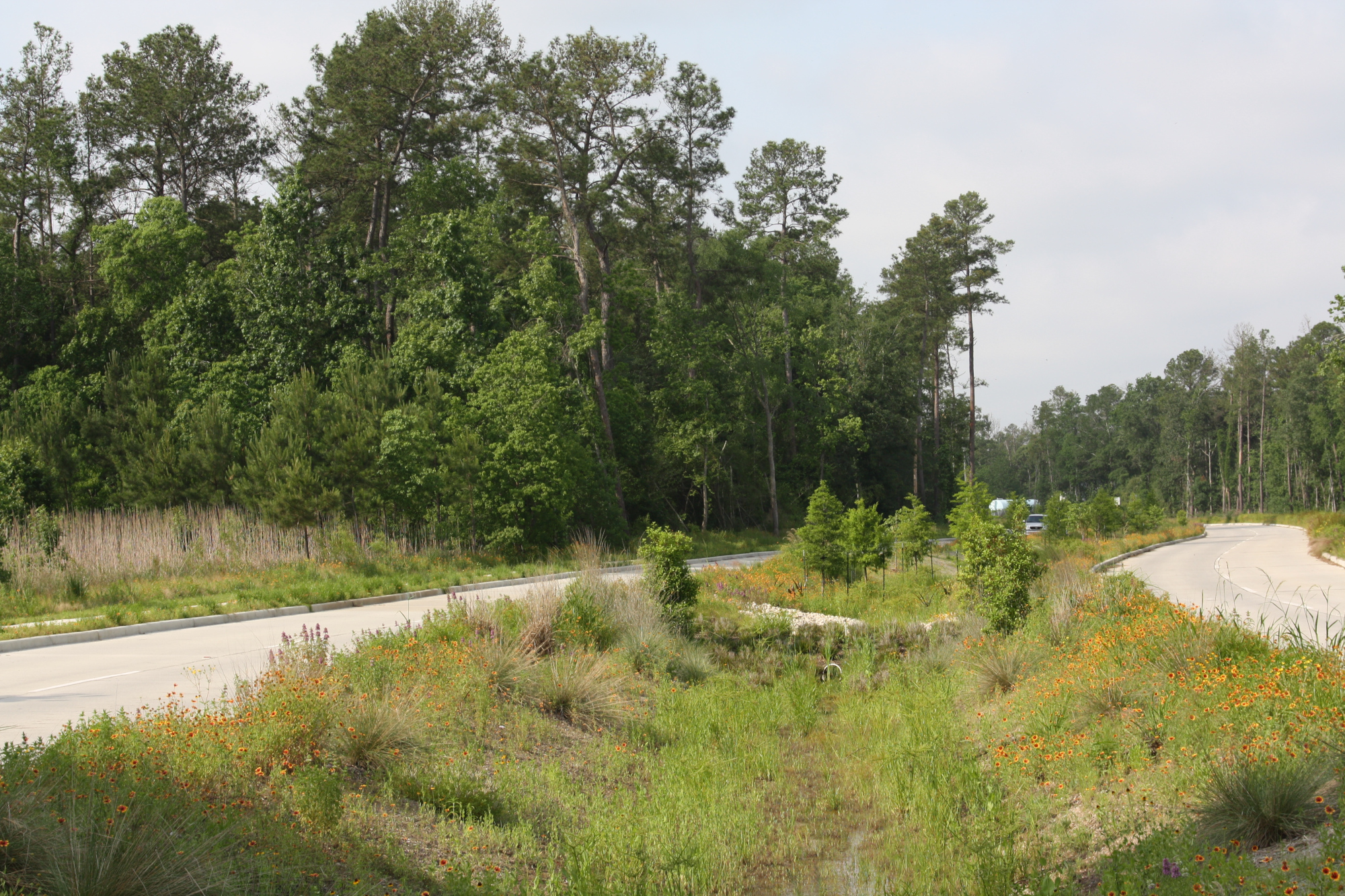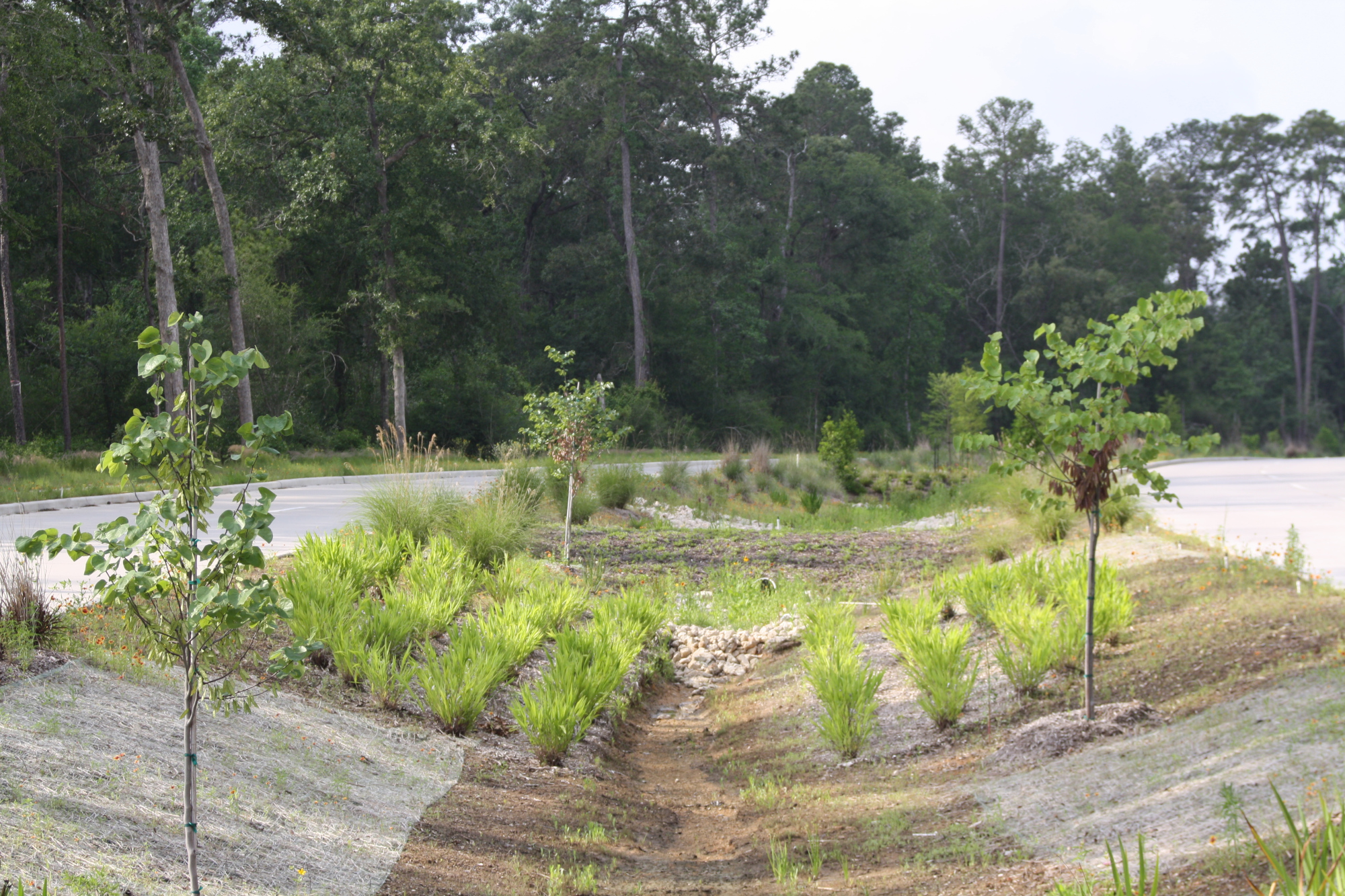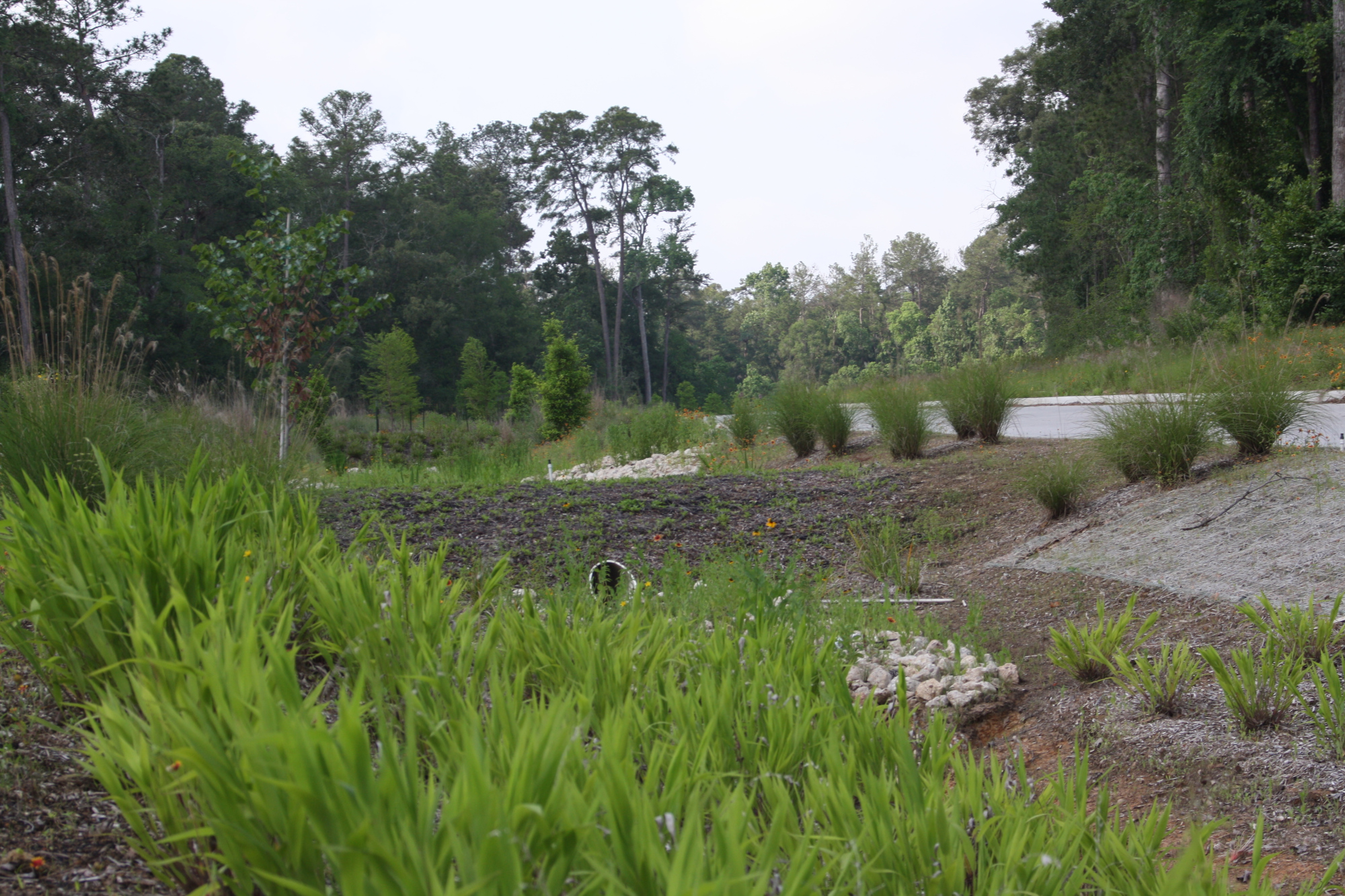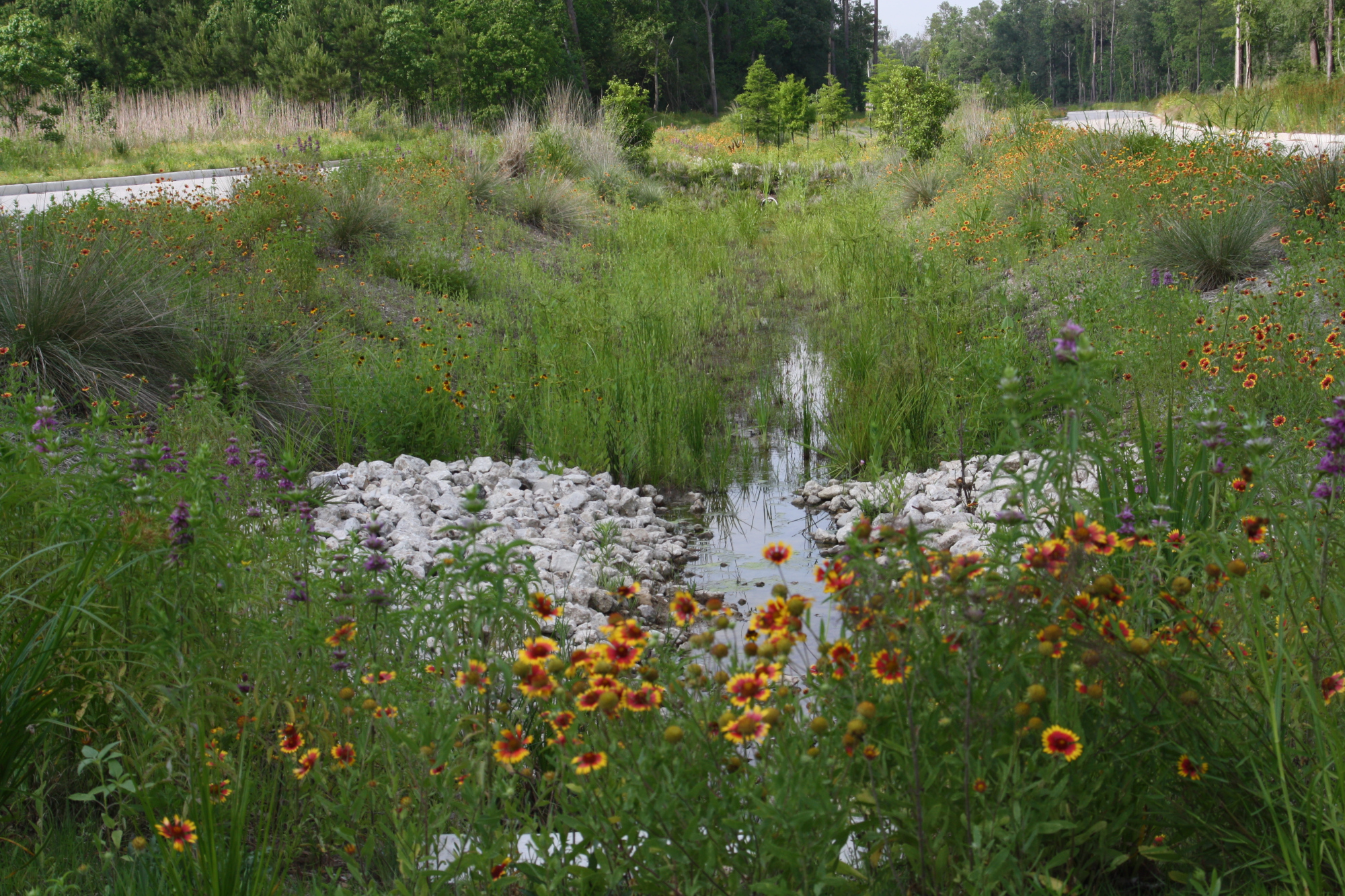
Green Roadway: Birnamwood Drive, Texas
Traditional Roadway vs. FocalPoint HPMBS
Birnamwood Drive located in northern Harris County, Texas, runs through a naturally forested area and connects a residential neighborhood at the south end to a park to the north end. It is a .74-mile stretch of boulevard contained within a 100ft right of way, with a center median swale that collects water from the street on either side, through false back inlets. Within the swales are a series of forebays that pond stormwater behind earthen berms, at the bottoms of which are 10” pipes that allow low flows through and extend time of concentration for larger storm events. At the low points of each swale, prior to discharge, an advanced high performance biofiltration system using a high flow rate engineered media is used to filter water that has made its way through the pretreatment forebays and vegetated swales, prior to discharging into Spring Creek at the north end and a Harris County Flood Control Ditch at the south end.
Like many regions throughout the country, the adoption and implementation of Low Impact Development (LID) and Green Infrastructure in Houston didn’t happen overnight, but the speed at which it has become a success story has astounded many outsiders, especially given our geographic and climatic conditions, and the lack of a regulatory requirement for the use of LID. This success was mostly due to an economics based approach that uses the market, not regulatory drivers, to promote Low Impact Development. Historically, TMDLs, CSO issues and/or a severely threatened water body were thought to be the most significant drivers for Low Impact Development. The history of Birnamwood Drive, Texas’ first Green Infrastructure based County Road, is one that can show any municipality in the country how to effectively implement Low Impact Development policy goals and how using it on their own capital projects can lead to saving millions of tax payer dollars.
In February of 2010, the Houston Land/Water Sustainability Forum (HLWSF) had just completed its nationally acclaimed Low Impact Development Design Competition. In that competition, a Harris County roadway that was slated to be expanded from a two lane roadway to a four lane boulevard was used as the subject property for the Green Roadway Design Challenge. Each of the three Design Challenges which made up the competition required design teams to answer three critical questions: 1) despite our 50+ inches of annual rainfall, clay soils which offer minimal infiltration potential and flat terrain, could Low Impact Development be adapted to keep post-development discharge curves below predevelopment rates and manage the 100-yr storm, 2) exceed current water quality standards, and perhaps most importantly, 3) could Low Impact Development based projects actually be less expensive to implement than conventional designs? Twenty-two teams competed, and every one of them showed that the three goals were achievable in each Design Challenge category, Green Roadway, Urban Redevelopment and Suburban Residential. Much to the surprise of almost everyone involved, the LID-based projects were better by almost any measure and less expensive, and the once-hesitant local design community had proven it to themselves.
For Harris County, the Green Roadway Design Challenge solutions, which were generated by some of the most prominent engineering consulting firms in the Houston area, provided an opportunity to lead. In concert with the HLWSF, a series of three workshops were scheduled over the course of three months. These full day workshops brought together a select group of local public agencies, including key staff from Harris County, the City of Houston and the Harris County Flood Control District, and a select group of engineers, architects, landscape architects and planners from the local design community, most of whom were veterans of the competition. Approximately sixty-five participants in all focused on identifying the obstacles and the options for implementing LID in the Houston area, with an emphasis on performance goals rather than getting caught up in over prescription and enabling a ‘get it done now’ approach. From these workshops, the Harris County Low Impact Development & Green Infrastructure Design Criteria for Storm Water Management was born. In this manual, the path was clearly paved for both private and public development to design using LID. No tax incentives, water fee reductions or other financial incentive was created to promote LID development; however indirect economic incentives were strategically built in to accelerate LID implementation. It all starts with a collaborative permitting process which effectively fast-tracks LID-based projects through the permitting process.
Another incentive for LID-based projects is reduced detention rates. Satisfactorily proving up the peak flow reductions inherent in LID design through increased time of concentration, allows LID-based projects to reduce required detention rates by as much as 47%, from .65 acre feet per acre developed to .35 acre feet per acre developed. In most cases, this results in a significant increase in Return on Investment for the developer, whether it be a retail development, a master planned community, or anything in between.
These two benefits, along with reduced infrastructure costs and reduced long-term maintenance costs, makes LID extremely attractive to the development community, but also to Harris County for its own projects. Birnamwood Drive was the first proof of these benefits. This first effort initially got the County’s attention when it required no traditional detention pond, saving the county more than $350,000 on land and excavation costs. Instead, all of the volume required was contained in the center median bioswale.
Even with the reduced costs for drainage infrastructure and detention pond, the LID design for Birnamwood Drive still needed to deliver water quality treatment in a way that would not increase costs to the point of exceeding the cost of a traditional roadway design. The first consideration was traditional slow flow rate biofiltration medias. This approach would have required a bioretention system to be installed throughout the entire 3/4-mile center median, meaning lots of excavation and a substantial network of underdrain pipe, running the cost upwards of $270,000. This would have negated most of the LID design cost savings, reducing them to perhaps 1%, but the bigger problem was with maintenance. In order to avoid compaction of the bioretention media, County maintenance crews would not have been able to use their typical machinery and established maintenance protocols on the entire bioswale. Concerned about the financial success of their first Green Roadway, Harris County began looking into new methods and materials.
Ultimately, an advanced High Performance Modular Biofiltration System (HPBMS), also known as FocalPoint, that incorporates a high flow rate engineered media was the answer. The system is as effective at pollutant removal as traditional engineered medias, but requires 1/20th of the footprint needed for traditional bioretention to match the flow velocity. The smaller footprint biofiltration system cost more than the traditional bioretention approach, but its greatly reduced size meant significant savings, roughly 50%, for the water quality treatment element of the project. The smaller footprint also allowed the vast majority of the vegetated swale upstream of the two small biofilters to be maintained using traditional County roadway processes. This solution was a win for the County and increased their savings for the LID design to 7% versus traditional pipe and pond. Subsequent LID-based Harris County roadways have saved far more money, but Birnamwood was a learning exercise that proved Harris County was on the right track.
Construction phasing had its own set of challenges. The contract was split into two packages, a civil package and a landscape package. The civil package covered the roadway, placement of false back inlets to discharge runoff into the swale, a small amount of storm sewer to convey water that had been cleaned through the bioswales into Spring Creek, and rough grading of the swales. After 9 months of construction, the roadway was complete and the project was handed over to the landscape contractor who was responsible for final grading the swales, planting the native plants throughout the swale and the installation of the biofiltration system.
Because of the efficiency of the high flow rate media and the resulting small footprint of the biofiltration system the excavation required to get the job done was greatly reduced. Once the excavation was complete, laborers hand placed the modular, flat pipe underdrain system that would be connected to the downstream storm sewer system. Once in place, a small excavator carefully backfilled 3/8” peagravel bridging stone, 12” around the sides and 6” above the underdrain, to separate the engineered soils from the underdrain. 18” of the engineered soil was then placed on top of the peagravel, followed by a 3” layer of shredded hardwood mulch.
Although the biofiltration system was installed during the landscape phase, there were numerous challenges with keeping the biofiltration system from clogging with sediment while the landscaper planted and waited for establishment of the native seeds which would stabilize the swale. Erosion control was a high priority and making sure there was adequate ground cover to prevent erosion was critical. The first step in preventing contamination of the biofiltration system was encasing it with a protective geotextile cover and surrounding it with wattles. This process created a permeable filter for the water to run through and prevented silt and sediment from penetrating. The placement of rock filter dams was also necessary upstream of the biofiltration system to both slow the velocity and prevent erosion of the swale bottom. Finally, the use of a high performance hydraulically applied or pinned in place erosion control blanket along the side slopes greatly improved the success of proper seed establishment. The combination of these best management practices helped keep the biofiltration system free of sediment during the construction process.
Once the bioswales were completely landscaped and stabilized, the geotextile cover was removed from the biofiltration system and the biofilter was tested for hydraulic conductivity. This pass/fail performance test is specified for installers of bioretention/biofiltration vendors in order to get final approval for payment from Harris County. With a passing result on the biofiltration system in hand, the plants were planted in the media bed and the system was activated.
Harris County, Harris County Flood Control District and the City of Houston are all making significant contributions to making Low Impact Development a viable alternative to traditional design in Harris County by focusing on the economics that drive implementation. Prior to the Houston LID Design Competition in 2010, beyond a few ‘tacked on’ LID features on a handful of projects, meaningful LID-based designs didn’t exist in the Houston area. In the subsequent three years, there have been roughly 50 projects completed using a complete LID approach, hundreds more have been designed, many of which are currently in construction ranging in scale from master planned communities with thousands of acres to Fortune 5 headquarters campuses to multifamily and mixed use developments to suburban roads and downtown green streets, to the neighborhood Starbucks.
Low impact Development was originally conceived in Prince George’s County, Maryland as a way to improve water quality AND lower the cost of compliance with stormwater regulations. What we’ve learned in the Houston area is the emphasis on LID/Green Infrastructure in meeting the new regulatory paradigm is well placed. If we start with the end in mind, focusing on our performance goals rather than our penchant for prescription, we create fertile ground for market driven implementation. The LID pioneers gave us the tools; cheaper and better always wins in the market.





